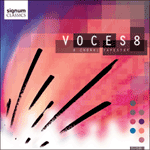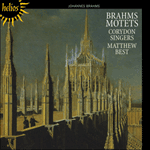
Welcome to Hyperion Records, a British classical label devoted to presenting high-quality recordings of music of all styles and from all periods from the twelfth century to the twenty-first.
Hyperion offers both CDs, and downloads in a number of formats. The site is also available in several languages.
Please use the dropdown buttons to set your preferred options, or use the checkbox to accept the defaults.

| Corydon Singers, Matthew Best (conductor)» More |
‘Warum ist das Licht gegeben?’ was composed during the idyllic summer of 1877 at Pörtschach, at a time when the composer was putting the finishing touches to his Second Symphony. The first performance was given in Vienna on 8 December 1878. After a severe and imposing four-part opening section in D minor (‘Slowly and with expression’), there follows a canonic setting of ‘Lasset uns’ in six parts (divided sopranos and basses), its warm, F major glow perfectly reflecting the underlying message of the words. The following section (‘Siehe, wir’) is in two halves, the second beginning at the words ‘Die Geduld Hiob’, which developes into a repeat of the music for ‘Lasset uns’. The motet is concluded by a four-part chorale setting to the words ‘Mit Fried und Freud’.
‘O Heiland, reiss die Himmel auf’, in four parts, was composed rather earlier, between 1863 and 1864, the format and mode of expression relating it to the first of the Op 29 motets with which it is roughly contemporary. It is in strict chorale variation form, the five sections being clearly marked by Brahms as ‘Versus I’ etc. in the score. After the opening chorale setting, ‘O Gott ein Tau’ (Versus II) places the chorale melody in the soprano line whilst the supporting parts sing a three-part canon based on a rhythmically diminished version of the same theme. ‘O Erd schlag aus’ introduces a rhythmic variant in the form of a triplet, whilst ‘Versus IV’ (‘Hie leiden wir’—Adagio) is a canon by inversion, whereby the overlapping part has the same melody, but with all the intervals turned upside down. ‘Da wollen’ continues this trend with a double canon (i.e. two canons sounded simultaneously) in inversion, the altos/tenors and sopranos/basses being paired. The final ‘Amen’ demonstrates the ‘stretto’ effect, whereby the various overlapping entries appear ever closer to one another, creating a superb final peroration.
from notes by Julian Haylock © 1991
«O Heiland, reiss die Himmel auf» en quatre parties fut composé un peu plus tôt, entre 1863–64; le format et l’expression s’apparentent au premier des motets de l’opus 29 dont il est presque contemporain. Sa forme est une stricte variation chorale, et les cinq sections sont marquées clairement par Brahms «Versus I», etc. dans la partition. Après la mise en musique chorale d’ouverture, le second verset «O Gott ein Tau» place la mélodie chorale dans le registre soprano pendant que les parties secondaires chantent un canon à trois parties basé sur une version rythmiquement diminuée du même thème. Le troisième verset «O Erd schlag aus» introduit une variante rythmique sous la forme d’un triolet, pendant que le quatrième verset («Hie leiden wir»—Adagio) est un canon par inversion où la partie chevauchante a la même mélodie, mais avec tous les intervalles renversés. Le cinquième verset «Da wollen» continue cette tendance au double canon (c’est-à-dire deux canons entendus simultanément) en inversion, avec les altos/ténors et les sopranos/basses arrangés en paires. L’Amen final démontre l’effet de «strette», selon lequel les différentes entrées imbriquées paraissent encore plus proches l’une de l’autre, ce qui crée une péroraison finale magnifique.
extrait des notes rédigées par Julian Haylock © 1991
Français: Alain Midoux
Das vierstimmige „O Heiland, reiss die Himmel auf“ entstand recht früh, nämlich um 1863/64, und sowohl das Format als auch die Art seines Ausdrucks sind der ungefähr um die gleiche Zeit entstandenen ersten Motette op. 29 verwandt. Von der Form her handelt es sich um einen Satz strenger Choralvariationen, dessen fünf Abschnitte von Brahms in der Partitur eindeutig als „Versus I“ etc. gekennzeichnet wurden. Nach der einleitenden Choralvertonung weist „O Gott ein Tau“ (Versus II) die Choralmelodie dem Sopran zu, während die Begleitstimmen einen dreistimmigen Kanon singen, der auf einer rhythmisch gestrafften Version des gleichen Themas beruht. „O Erd schlag aus“ führt als rhythmische Variante Triolen ein, und Versus IV („Hie leiden wir“—Adagio) ist ein invertierter Kanon, dessen überlappende Stimme die gleiche Melodie, jedoch mit umgekehrten Intervallen aufweist. „Da wollen wir“ setzt diese Tendenz mit einem invertierten Doppelkanon (d.h. zwei gleichzeitig vorgetragenen Kanons) in der Paarung Alt/Tenor und Sopran/ Baß fort. Das abschließende „Amen“ ist ein Beispiel für den „Stretto“-Effekt, bei dem die gestaffelten Einsätze immer dichter aufeinanderzufolgen scheinen, so daß ein herrlicher Abschluß entsteht.
aus dem Begleittext von Julian Haylock © 1991
Deutsch: Anne Steeb/Bernd Müller
 A choral tapestry A choral tapestryA Choral Tapestry' explores the rich vocal timbres of sacred vocal music spanning five centuries. Interweaving genres create an ethereal sonic tapestry that centres around the haunting beauty of William Byrd's Mass for Four Voices. The programme i ...» More |
 Brahms: Motets Brahms: Motets‘A must for any serious collector’ (Organists' Review) ‘Ideal for the more adventurous listener who enjoys a ramble down the lesser-known by-ways of the musical repertoire’ (The Music Magazine)» More |

